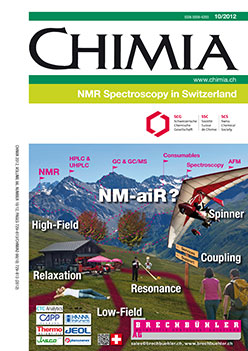Automated Projection Spectroscopy (APSY) for the Assignment of NMR Resonances of Biological Macromolecules
DOI:
https://doi.org/10.2533/chimia.2012.770Keywords:
Apsy, Automated assignment, Automated projection spectroscopy, High-dimensional experiments, Novel sampling approachesAbstract
High resolution nuclear magnetic resonance (NMR) spectroscopy in solution is an established technique in structural biology. Detailed functional and structural studies of biological macromolecules by NMR require the assignment of the chemical shifts to specific nuclei. In biological applications, the necessary data is usually obtained from a number of two- and three-dimensional (2D and 3D) NMR experiments. Often, these data cannot be fully analyzed by automated computer programs due to insufficient separation and resolution of the signals in the available spectra. Then, complete resonance assignment requires manual interaction and can become a long and labor-intensive task. Automated projection spectroscopy (APSY) allows the substantial improvement of the resolution by providing spectral information from four and higher dimensional experiments without measuring the full spectrum, which would by far exceed any acceptable measuring time. APSY only measures a series of projections of the high-dimensional spectrum which can be obtained in a much shorter time. Peak picking of the projection spectra provides the basis for the calculation of the high-dimensional chemical shift correlation space by the algorithm GAPRO. The resulting high-dimensional peak lists are commonly artifact-free and of exceptional precision. Along with their high number of correlated nuclei they provide an ideal basis for reliable automated assignment. We will introduce the basic concepts of APSY, illustrate them with an application of a 6D APSY-seq-HNCOCANH experiment, and discuss some practical aspects.Downloads
Published
2012-10-31
Issue
Section
Scientific Articles
License
Copyright (c) 2012 Swiss Chemical Society

This work is licensed under a Creative Commons Attribution-NonCommercial 4.0 International License.
How to Cite
[1]
B. Krähenbühl, G. Wider, Chimia 2012, 66, 770, DOI: 10.2533/chimia.2012.770.







